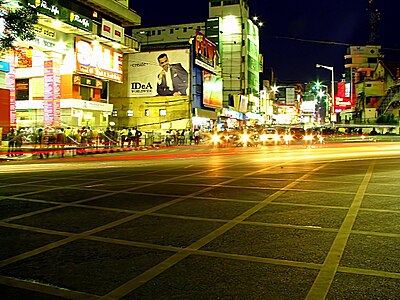
Search
Bangalore Urban district

Bangalore Urban district is the most densely populated of the thirty-one districts that comprise the Indian state of Karnataka. It is surrounded by the Bangalore Rural district on the east and north, the Ramanagara district on the west and the Krishnagiri district of Tamil Nadu on the south. Bangalore Urban district came into being in 1986, with the partition of the erstwhile Bangalore district into Bangalore Urban and Bangalore Rural districts. Bangalore Urban has three taluks : Bangalore City, Yelahanka and Anekal. It has seventeen hoblies, 872 villages, eleven rural habitations, five towns, one tier-three city and one tier-one city, administered by ninety-six Village Panchayats (Grama Panchayitis), ninety-seven Taluk Panchayats (Taluk Panchayitis), five Town Municipal Councils (Purasabes), one City Municipal Council (Nagarasabe) and one City Corporation (Mahanagara Palike).
The district had a population of 6,537,124 of which 88.11% is urban as of 2001. As of Census 2011, its population has increased to 9,621,551, with a sex-ratio of 908 females/males, the lowest in the state and its density is 4,378 people per square km.
List of Villages
Administration
The district administration is headed by a Deputy Commissioner, who is an IAS officer. There are various officials both at the district level and at the taluk levels to assist the Deputy Commissioner. They include the Assistant Commissioner’s (Sub-Divisional Magistrate), Tahsildars, Shirstedars, Revenue Inspectors and Village Accountants.
Geography
Climate
The climate here is moderate. The lowest average temperature is about 16–18 °C (61–64 °F).
Water
According to the National Wetland Atlas (2010) the district has two main rivers and 580 wetlands.
Demographics
According to the 2011 census Bangalore Urban district has a population of 9,621,551, roughly equal to the nation of Belarus. This gives it a ranking of third in India (out of a total of 640). The district has a population density of 4,378 inhabitants per square kilometre (11,340/sq mi). Its population growth rate over the decade 2001-2011 was 46.68%. Bangalore has a sex ratio of 908 females for every 1000 males, and a literacy rate of 88.48%. 90.94% of the population lives in urban areas. Scheduled Castes and Scheduled Tribes make up 12.46% and 1.98% of the population respectively.
At the time of the 2011 census, 44.47% of the population spoke Kannada, 15.20% Tamil, 13.99% Telugu, 12.11% Urdu, 4.55% Hindi, 2.94% Malayalam and 1.92% Marathi as their first language.
Temples
- Gavi Gangadhareshwara Temple
- Dodda Basavana Gudi
- Halasuru Someshwara Temple, Bangalore
- ISKCON Temple Bangalore
- Kote Venkataramana Temple, Bangalore
- Banashankari Amma Temple
See also
- Ajjanahalli, Bangalore South
- Bangalore Division
References
External links
- Official website of Bangalore Urban District
Text submitted to CC-BY-SA license. Source: Bangalore Urban district by Wikipedia (Historical)
Owlapps.net - since 2012 - Les chouettes applications du hibou


